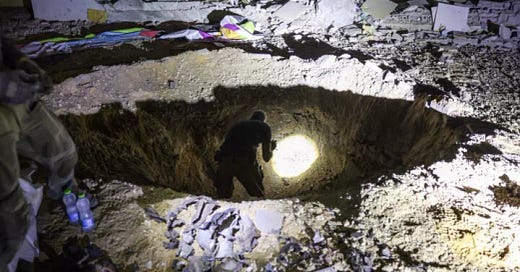Interview with Agence France-Presse (AFP) on the limits of Iran's missile power
I gave an interview to Agence France-Presse (AFP) published on Thursday 03 October 2024 on the limits of Iran’s missile power.
You can read my full responses to the AFP interviewer’s questions, which were not included in their entirety in the final article, below:
Iran seemed to have fired 180 missiles (according to the Israelis), 200 (what they claim). There’s no talk about the use of drones while April’s attack consisted mainly of drones (some 300 out of 350 vectors). What could explain such a somehow restrained posture, knowing most of the missiles would be intercepted?
The attack this time around was less restrained and more escalatory compared to the attack in April. While Iran used more standoff weapons last time - around 320 - it gave more lead time to Israel and its allies to prepare their air defences, and used mostly older and less effective systems in its arsenals, including around 170 drones that moved slower and on a more predictable trajectory and were therefore easier to intercept.
This time around Iran is believed to have used between 180 to 200 ballistic missiles, including some of its most advanced platforms like the Fattah 1 missile, which were on average more difficult to intercept than the barrage in April. This recent strike, as a consequence, appears to have been relatively more effective and had a bigger psychological impact on the Israeli leadership and public.
If Iran signaled a controlled escalation yesterday, what are their goals?
In April of this year, Iran laid down a redline (what it called a "new equation") that any attacks on its interests, assets, leaders, or citizens by Israel would be met with a direct retaliatory strike from Iran.
Despite this redline, since then, Israel is believed to have carried out attacks and sabotage of military infrastructure inside Iran; killed several IRGC officers in Lebanon and Syria (including killing a senior general and injuring an ambassador), with total IRGC deaths since December 2023 possibly numbering more than two dozen; and assassinated Hamas leader Ismail Haniyeh in Tehran and the Hezbollah senior military leadership and its secretary general Hassan Nasrallah, the latter being probably the most senior figure in the so-called Axis of Resistance besides Iranian Leader Ayatollah Ali Khamenei himself.
The Iranian leadership therefore felt compelled to give some kind of response to Israel to maintain its credibility in the eyes of international and domestic audiences, especially its core supporters at home and Axis of Resistance in the region, who had been dismayed by Iran's lack of response since Haniyeh's assassination in late-July. However, I believe they also calibrated the attack with the goal of not triggering a major Israeli and US response - a very difficult needle to thread.
Do we have an idea about Iran’s missile stockpiles and their capacity to regenerate their inventory? Iran has been providing missiles to the Houthis, to Russia: is it sustainable to continue to do so as they are also firing missiles themselves?
Iran has one of the largest missile and drone arsenals in the world and can furnish its own forces with these weapons while supplying Russia (in terms of missiles only short-rang ones so far) and its Axis of Resistance partners (most of whom have developed some local missile and drone production capacity of their own)
However, it's stockpile and production of missiles able to reach Israel is limited. The key question moving forward in this conflict is: (a) What is Iran's launch capacity (i.e. how many ballistic and cruise missiles and drones that can reach Israel can it fire in a single volley) (b) it's missile stockpile and the replenishment rate, and (c) at what rate is its launch capacity and stockpile likely to be reduced over time by enemy counterattacks?
This information may be available to the Israeli or US intelligence communities, but I am not aware of publicly available and credible figures. However, I would assume it has a capability that is sufficient to a inflict serious damage on Israel in a short period of time (a few weeks or months), but not one that is sufficient for a longer conflict (especially as launch capacity, stockpiles, and manufacturing capacity are destroyed).
Some analysts assert that Iran lost credibility of its deterrence given recent blows to Hamas, Hezbollah and the few effects of its missiles strike? What are your views on this?
Two things have happened. The first is that the military capacity of the Axis of Resistance has been seriously eroded, with Hamas largely destroyed except for limited guerrilla operations, and Hezbollah's senior military leadership decapitated and at risk of having its rocket and missile arsenal destroyed.
The second is that perceptions of Iranian power have been damaged by its reluctance to directly respond to Israel, and the relatively ineffectiveness of operations "True Promise" 1 and 2, in April and October, respectively. The limits of Iran's power versus Israel have been revealed by these events.
But I also think that in an all out war scenario, Iran and its network could still do catastrophic damage to Israel, even if they would not be well positioned to "win" such a conflict if the United States entered the fray. Iran knows this, and has therefore acted with relative restraint in responding to Israeli attacks (which it has endured for decades), instead seeking to indirectly inflict severe military, diplomatic, political, social, and economic damage to Israel over a long period of time, while minimizing the retaliation and cost to itself. So I think it's a mistake to dismiss Iran's missile and drone power and Axis of Resistance network entirely without viewing recent events in context.




